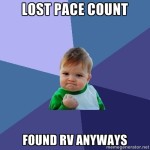 Being able to calculate distance traveled while on foot is a critical skill, it could literally mean the difference between life and death given the right set of circumstances. Imagine that the proverbial SHTF has occurred and you now have 7 days to link up with your group at a predetermined location 90 miles from your home. Moving by vehicle is out of the question as all of the surrounding roads are blocked, which means you must travel by foot. You will be required to move mostly at night going cross country and sometimes using less known back roads in order to reach your destination. Simple math says that you must move at least 13 miles per day in order to meet your group at the required time, but how would you determine how far you have traveled each day? While you could attempt to walk from sunset to sunrise it would be much better to split up the movement into manageable chunks in order to avoid injury and unnecessary fatigue.
Being able to calculate distance traveled while on foot is a critical skill, it could literally mean the difference between life and death given the right set of circumstances. Imagine that the proverbial SHTF has occurred and you now have 7 days to link up with your group at a predetermined location 90 miles from your home. Moving by vehicle is out of the question as all of the surrounding roads are blocked, which means you must travel by foot. You will be required to move mostly at night going cross country and sometimes using less known back roads in order to reach your destination. Simple math says that you must move at least 13 miles per day in order to meet your group at the required time, but how would you determine how far you have traveled each day? While you could attempt to walk from sunset to sunrise it would be much better to split up the movement into manageable chunks in order to avoid injury and unnecessary fatigue.
The Pace Count
Enter the pace count, a method for determining distance traveled while on foot. The method is quite simple in that you count the number of steps which you take while walking and correlate that to distance traveled. Of course in order to make this work you have to establish a personal base line and by that I mean figure out how many of your steps = X distance. My stride will be different than your stride and so it is worth noting that pace count will differ between individuals. The second thing you have to understand is that it’s much easier to pace count every other step while walking, either your left or right foot (I pace count on my left foot).
Determining Personal Pace Count
Now it’s time to figure out just how many of your steps = X distance. Utilizing a measuring tape or GPS mark off 100 meters on an empty road, in a field, on a trail through the woods. Once you have your distance measured out start at one end and walk to the other counting the number of times your left (or right) foot hits the ground. Do the same exercise coming back, if the numbers are slightly off take the average of the two. Now you know that it takes 65 normal paces (for example) to walk 100 meters on FLAT terrain. I emphasize the flat terrain because many other factors could alter your pace count or render it altogether useless, some of these would be:
1- Movement speed (running pace count is different)
2- Terrain (Moving through heavy woods, up and down steep elevation, through swamps).
3- Weather (Rain and mud).
4- Gear (Wearing a 75lb pack)
5- Visibility
Doing the Math
Let’s go back to the example I wrote about in the first paragraph, you know that you need to move 13 miles per day in order to make the link up location in time with your group. Your pace count is in meters (standard for MGRS maps) so there will have to be a conversion since the only map you have is the road atlas which was in your glove box (the one which you measured and gave you the distance of 13 miles per day). Every mile = 1.6093 kilometers so…13 miles per day = 20.9 kilometers per day. You know that it takes 65 paces to equal 100 meters but that does NOT mean you’ll be counting to 13,585 every day (65 x 10 x 20.9).
Practical Application of the Pace Count
You need to move 20.9 Kilometers per day so that means you’ll need 10 small rocks, coins will work well in this instance if you don’t have rocks. Put all of the rocks or coins in your left pocket, every time you move 100 meters (65 paces) transfer a rock or coin to your right pocket. You might wonder what the purpose of this could be but trust me there will be a time where you stop to look at the map and then wonder…”have I moved 300 or 400 meters?” Once you have successfully moved all 10 objects from one pocket to the next this will indicate the completion of a full kilometer of movement, mark that down on your map or notebook utilizing a simple hash mark. In the example I listed out above you would repeat this process 20 times daily, moving 9 rocks the final time for the last 0.9 kilometers of movement.
Conclusion
I’ve tried to oversimplify a very important tool which can be used to track distances while moving on foot. There are many electronic aids which completely negate the need for this skill but should those fail you could be lost in the sauce, quite literally if a swamp is involved. I have intentionally not tried to integrate teaching points surrounding MGRS maps or lensatic compasses because those could muddy the waters and take away from the singular point I hope to make here in this post. Take it upon yourself to know how many of your steps equates to 100 meters and you’ll be much better off. Remember too that there are many factors which can influence your pace count so it is most definitely not a figure which is set in stone.









4 comments
Skip to comment form
Great article PJ. Pace count is very critical and something that everyone should determine and practice now.
Author
It really is one of those things you can set up and determine within 5 minutes!
Practicing pace count is the building block of terrain assocation. It helps get someone used to judging distance. Then you can add to it practicing terrain association. Once you get it down you can glance at a map and say “i need to go north 200 meters, cross a creek, follow a ride line keeping it on my left, and end at fork in the road on my right”. This allows you to navigate great distances (based on frequency of terrain features) without even getting a compass out or looking at your map a second time. Another good thing to plan when navigating using a map and compass is a backstop. Look at your map and think “if I get this road going east and west I have gone too far”. This allows you to keep yourself from walking in circles if you have a waypoint to keep you on track.
Author
Great point about the backstop, definitely something worth considering when traveling with a map.